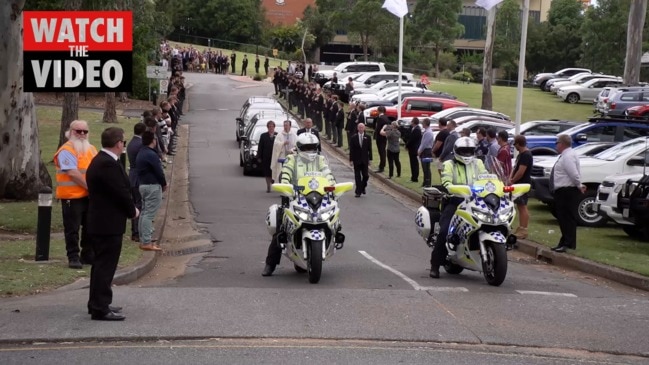Push to increase sentence for teen who killed Matt Field, Kate Leadbetter and unborn child
Queensland’s top prosecutor has pushed for an increase to the sentence of a teenager who killed a young Queensland couple and their unborn son.

Queensland’s top prosecutor says the community has reached a point where it expects the courts to take a different approach in its sentencing of hard-core juvenile offenders.
Director of Public Prosecutions Carl Heaton KC made the submission in an appeal hearing for a teenager who killed a young couple and their unborn child, arguing his 10-year sentence should be increased to properly punish the “revolting” and “wicked” crime.
Mr Heaton argued the sentencing judge had not placed enough weight on the importance of protecting members of the community who had an expectation to feel safe in their beds at night.
But the boy’s lawyers have submitted the 10-year sentence was excessive and his extremely prejudicial upbringing reduced his moral culpability, arguing a nine-year sentence was more appropriate.

The now 19-year-old was sentenced last year to 10 years’ imprisonment with parole release after serving six for the manslaughter of Matthew Field and his pregnant partner Kate Leadbetter.
The couple was killed when the drunk and high teen, then aged 17, ran a red light in a stolen car, slamming into them as they walked their dogs at Alexandra Hills on Australia Day 2021.
The boy had an extensive criminal history that included more than 20 convictions for car theft.
The Attorney-General appealed the sentence, arguing it was manifestly inadequate, submitting a sentence of 14 years would be more appropriate.
But the boy’s lawyers have also sought leave to appeal against the sentence, submitting the penalty was excessive.
The maximum penalty for a juvenile convicted of manslaughter is 10 years’ imprisonment.
However the maximum increases to life if it is established the offence was both an act of violence and was “particularly heinous”.
In sentencing last year, Justice Martin Burns found the offending had been particularly heinous, but did not sentence the teen above the 10 year maximum as was open to him.
Director of Public Prosecutions Carl Heaton KC, for the AG, on Tuesday argued in the Court of Appeal that the sentence imposed failed to properly reflect the serious nature of the offending and did not place enough weight on the importance of community protection.
“It’s perhaps sad to say but relevant that the cohort of offenders that this defendant falls within is precisely the cohort of offenders that it is necessary that the courts deter by the imposition of strong sentencing responses,” Mr Heaton said.

Court of Appeal President Debra Mullins asked if Mr Heaton was referring to a cohort like the respondent who came from a dysfunctional upbringing.
“So is that the cohort of offenders you’re talking about – where the court is left to deal with the outcomes when there was a community problem that needed to be addressed in this young man’s life at a much earlier stage,” Justice Mullins asked.
Mr Heaton replied: “The cohort I’m referring to is young people who steal motor vehicles and drive dangerously with no regard to their own safety or the safety of other road users and members of the community.”
“It is a common feature that those that fall within that cohort have a background that reflects those circumstances which are present here,” he said.
Mr Heaton said the legislation was designed to provide the tools for the court to compensate for child offenders with disadvantaged backgrounds like that of the respondent in this case.
“But there comes a point when the courts must respond differently and that point is reached in the circumstances here,” he said.
“The court had tried on previous occasions to impose constraints, support to turn the offending conduct around to no avail.
“On each of the occasions when he appeared before the court, the court was told that he had insight, that he was remorseful and yet it didn’t change his criminal offending conduct.”
Mr Heaton said the courts recognised and reflected the community’s acknowledgment that there was a “collective responsibility” to prevent children from suffering similar disadvantages as the boy in this case.
“But even in acknowledging that the community says there comes to a point when we get all of that but we want to feel safe when we’re going about the streets, when we’re sleeping in our beds at night, so there’s a limit of relevance or the prominence of that within the sentencing discretion,” he said.

“I don’t mean to infer at all that is to be ignored, of course it’s not.
“In my submission it is safe to say the community is rightly at a point where they expect the courts to impose a different sentencing approach to curb what is a prominent and regrettably all too frequent occurrence in the community.”
He argued the case “powerfully fit” the characterisation of being particularly heinous.
Mr Heaton said the juvenile’s actions in stealing the car and “wreaking havoc” appeared to be “purely for his own entertainment” and unlike many young car thieves spurred on by passengers, “this was all of his own doing”.
“The victims of his criminal conduct were completely innocent simply making their way out and about in the community,” he said.
“The catastrophic outcome was, it can be said, all but inevitable having regard to the conduct he displayed earlier that day.”
Mr Heaton said material placed before the sentencing judge indicated the boy was a moderate risk of reoffending.
“It is necessary for the community acting through the courts to impose upon him the structure, the support, the routine, the regime that has been lacking up until this point in his life and that then can come for him through the custodial environment,” he said.
“It is perhaps the sad reality that those features, that stability, structure, discipline and support in the community have failed to properly guide him on the path to rehabilitation and pro social and lawful conduct such that now the community remains at too great a risk from him.”
Defence barrister Ruth O’Gorman KC submitted that while community protection was “undoubtedly very important”, that factor must not outweigh the mitigating circumstances set out by the Youth Justice Act.
Ms O’Gorman said the court needed to take into account that child offenders had the capacity to change, reintegrate into society and contribute meaningfully.
She submitted the child in this case had demonstrated he had that capacity.

Ms O’Gorman said it was important to recognise the teen would inevitably be released and “the sentence that is imposed on him must do the best it can to ensure that when he is released back into the community he is somebody who is less of a danger to the community than he presently is”.
She submitted that a sentence of nine years was a more apt way to achieve that than one of 14 years as proposed by the AG.
Lawyers for the teen argued against the finding that the offending had been particularly heinous.
Justice Mullins said in a comparable case, a judge spoke of an offence being particularly heinous “where it inspired a sense of outrage”.
“And I have to say I feel that is applicable in this particular case,” she said.
“I mean these were just a couple walking their dogs and members of the community should be able to expect that they can safely walk around the streets without losing their lives.”
Ms O’Gorman said if that was the only test, this case would meet that threshold.
But she argued other factors needed to be considered including the teen’s prejudicial background, age, intoxication and mental health.
“When it came to his level of functioning and level of culpability in the terrible offences he committed against that background … we make the submission that when one takes that into account in conjunction with the objective seriousness of these offences that these offences were not particularly heinous,” she said.
“His moral blameworthiness was not only not the same as an adult, but it was not even the same as another child of his age.”
Ms O’Gorman said the teen came from an “extremely prejudicial” background.
“He was someone who from all the material was very badly mistreated seemingly from birth and certainly from a very young age,” she said.
“He was exposed to adult drug use and violence perpetrated on his mother, violence which extended to himself, severe neglect, a severely disrupted education which saw him going to a number of different primary schools but no further…”.
The teen was bounced between foster homes and attempted suicide at age nine.
“So in terms of his subjective factors, sight must not be lost of the matters (he) endured through no fault of his own,” she said.
The case was heard before Court of Appeal President Debra Mullins, acting Justice Robert Gotterson and Justice James Henry.
The decision has been reserved.
Outside court, a tearful Russell Field and his wife Ann said the family would now wait for the court’s decision to be handed down.
“We thank everybody who has got us this far in getting this appeal,” he said.
“I’d just like to thank everybody in the community and our supporters.”
Mr and Mrs Field, who lost their son Matthew in the crash, have previously criticised the “lenient” sentence handed to the juvenile killer.
If the sentence remains unchanged, he will be released on January 26, 2027 – the anniversary of the deaths of Kate, Matt and their unborn son Miles.




